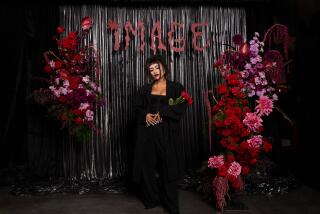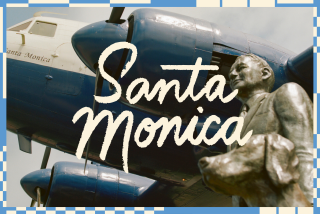A Fantasy Cruise on High Seas : Benefit: When the S.S. Monte Carlo finally docked, about $125,000 had been raised for the San Diego Museum of Contemporary Art.
LA JOLLA — S.S. Monte Carlo--a ship of the bejeweled, a voyage of the grand--steamed away from the San Diego Museum of Contemporary Art on Saturday night with a complement of 550 passengers, all of them intent on games at sea.
The fact that the realistic smokestacks perched on the museum roof belched pina colada -scented smoke (actually dry ice vapors, potent enough to wilt the most elaborate coiffure) should be enough to endow the essential goofiness of this fantasy high-seas romp with a crystalline clarity.
Other installments of the annual “A Night in Monte Carlo” gala have taken guests to the circus, on a jet-set tour of the globe and even to Neiman-Marcus, but Saturday’s version, the 14th in the series, demanded that participants imagine the museum’s concrete walks and terrazzo floors to be pitching and rolling beneath their feet. The only real rolling, however, was high stakes rolling at the gaming tables, where the pseudo-seasick repeatedly tossed their chips at the roulette wheels.
For “S.S. Monte Carlo,” the museum became a 1930s luxury liner outfitted with Art Deco detailing, an extensive casino and a rather good kitchen. Guests boarded via a gangway that entered through a convincingly painted depiction of the imaginary ship; at the end, a phalanx of uniformed stewards waited with trays of Champagne and caviar tartlets.
Gala chairman Deirdre Dooling declared the S.S. Monte Carlo “a decadent ship embarked on a mission of fun,” but at most times the party took a tone more nautical than naughty. Portholes, borrowed from a marine salvage firm and arranged along the museum walls, opened onto photographs of Mediterranean scenes to enforce the illusion that the ship was sailing a course that called on ports from Lisbon to Nice. Deck chairs added to the make-believe mood and also offered respite to weary souls; guests who parked themselves in the gallery that faces La Jolla Cove were treated not only to recorded sea noises that thrummed in the manner of seashells held to both ears, but to the sight of the spotlighted swells crashing below.
Most of the swells did not crash, of course, although a few clashed; the impetus to wear nautical attire nearly ran amok and there were enough brass buttons, gilded epaulets and lengths of gold braid shaped around pretty shoulders to outfit a flotilla’s worth of commodores. And had not the majority of the sailor suits been beaded or sequined, the Shore Patrol might have been tempted to raid the place in search of AWOL seamen.
If “A Night in Monte Carlo” is known for any one quality, it is for being kicky and even a touch campy; while certainly grand, it forgoes formality in favor of high spirits. That point of view guides the plans made by event chiefs. Said co-chairman Paulette Gibson: “People don’t feel formal or constrained at ‘A Night in Monte Carlo,’ they feel classy .”
“You don’t feel pretty on the S.S. Monte Carlo,” added Dooling. “It’s a cruise ship, and its masculine, but you do feel elegant and sophisticated because there’s excitement and electricity.”
Some of the electricity Saturday night was simply the result of tradition: “A Night in Monte Carlo” typically is a high-voltage crowd-pleaser. Museum board President Jackie Axline said, “As far as I’m concerned, ‘Monte Carlo’ is the party in town.”
But most of the jolt came from special features like the Peter Sprague combo, stationed on the roof above the forecourt playing sambas while strings of maritime flags fluttered overhead and the smokestacks spread a perfumed fog through the scene. The fog wreathed the loins of a pair of springing, black-stone panthers that held a basin and fountain between their raking claws; in their stylized pose, they created an image snatched from a sketch in a 1930s fashion magazine.
At some “Monte Carlo” galas, the museum’s walls have been painted to suit the party theme--at 1988’s “Artquake,” the guests themselves donned protective plastic smocks and splashed the walls with primary colors--but for S.S. Monte Carlo, the committee invited artists Gerrit Greve and Larry Mansker to install sea-themed artworks. Greve lined one casino with selections from his “Water Series,” canvases that interpret the waves in action in various moods; Mansker brought La Jolla Cove indoors with an idealized scene and also brought along canvases of pleasure boats sailing the Mediterranean.
The party’s 1930s motif was captured best in the tented outdoor ballroom, finished in bronze and platinum tones and brought alive by striking centerpieces that rose more than eight feet above the table tops and almost seemed to have been carved from massive blocks of an imaginary, Art Deco landscape.
“They’re a mixture of sculpture and romance,” said floral designer Rene Van Rems of the arrangements of dahlias, orchids, roses, papyrus fronds and glowing, phosphorescent wands that sprouted from narrow, silvery urns. “Usually you just have one or the other.”
“The S.S. Monte Carlo is not the Love Boat,” said decor chairman Melanie Cohrs. “It’s like going back to 1935 and sailing aboard the Queen Mary, with Noel Coward leaning over the railing getting seasick and Marlene Dietrich showing off her legs while high society does double take.”
The tent was named the Grand Savoy Ballroom, although at times it took on the frantic air of the big top. Rhapsody, a 21-piece orchestra from Los Angeles, caused a crush on the dance floor that forced up the temperature under the tent; during breaks in the music, mess-jacketed servers laid out a meal of ahi and goat cheese salad and roast tenderloin in Port sauce. Tony Kopas catered the main event, and the U.S. Grant hotel spread out the dessert buffets of pastries and fruit-stuffed crepes.
The Bob Long Trio played a more intimate style of music in the indoor cabaret, which opened after dinner and offered an alternative to the gaming tables. Few lost the chance to multiply their chips, however, since they could be redeemed for raffle tickets that offered chances on more than 100 prizes.
Dooling said the event would earn $125,000 for the museum, a pronouncement that cheered museum director Hugh Davies. “I like the S.S. Monte Carlo,” he said. “It’s like the museum, like a frigate plowing through the waters of Modernism.”
The guest list included Sue and Charles Edwards, Susie and Rob Lankford, Judy Courtemanche, Barbara and Chuck Arledge, Carolyn Farris, Ingrid and Joe Hibben, Collette and Ivor Royston, Dorothy and Bob Shapiro, Carol Randolph and Bob Caplan, Liz and Mason Phelps, Leila Armstrong-Goetz, Sophie and Art Brody, Jeanne Lawrence, Joan and Irwin Jacobs, Leslie Simon and Michael Krichman, Mary and Walt Smyk, Helen and Jose Tasende, Nancy and Henry Hester, Jeanette and Bob Wright, Patrick Dooling, Mac and Tim Canty, Patti and Ron Mix, Hedy and Richard Niblack, Dona and Don Whitaker, Margaret and Victor Sell, Melissa and Max Elliot, Chris Corsini with John Champion, Pauline and Stanley Foster, and Heather and Jack Metcalf.
More to Read
The biggest entertainment stories
Get our big stories about Hollywood, film, television, music, arts, culture and more right in your inbox as soon as they publish.
You may occasionally receive promotional content from the Los Angeles Times.










